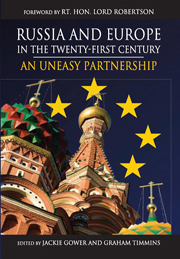Book contents
- Frontmatter
- Contents
- List of Contributors
- Acknowledgements
- List of Abbreviations/Acronyms
- Foreword Russia and Europe
- Preface
- Introduction Russia and Europe: What Kind of Partnership?
- PART 1 Russia looking West
- Chapter 1 Vladimir Putin and Russian Foreign Policy towards the West: Towards a New Realism
- Chapter 2 The ‘Normalization’ of Russian Politics and Europe
- Chapter 3 The Russian Elite Perspective on European Relations
- Chapter 4 Domestic Politics and Foreign Policy Formulation
- Chapter 5 Russia's Regions in Shaping National Foreign Policy
- Chapter 6 The Russian Military and European Security Cooperation
- PART 2 Europe looking East
- PART 3 Partnership in Practice
- Conclusion Russia and Europe: An Uneasy Partnership 289
- Index
- More Titles in this series
Chapter 6 - The Russian Military and European Security Cooperation
from PART 1 - Russia looking West
Published online by Cambridge University Press: 05 March 2012
- Frontmatter
- Contents
- List of Contributors
- Acknowledgements
- List of Abbreviations/Acronyms
- Foreword Russia and Europe
- Preface
- Introduction Russia and Europe: What Kind of Partnership?
- PART 1 Russia looking West
- Chapter 1 Vladimir Putin and Russian Foreign Policy towards the West: Towards a New Realism
- Chapter 2 The ‘Normalization’ of Russian Politics and Europe
- Chapter 3 The Russian Elite Perspective on European Relations
- Chapter 4 Domestic Politics and Foreign Policy Formulation
- Chapter 5 Russia's Regions in Shaping National Foreign Policy
- Chapter 6 The Russian Military and European Security Cooperation
- PART 2 Europe looking East
- PART 3 Partnership in Practice
- Conclusion Russia and Europe: An Uneasy Partnership 289
- Index
- More Titles in this series
Summary
Introduction
The period since the end of the Cold War has witnessed a transformation of the European security map and – as a necessary precondition of this – of politicalmilitary relations between Russia and Europe. The withdrawal of former Soviet forces from Central and Eastern Europe (CEE), the conclusion of arms control arrangements – in particular the Treaty on Conventional Forces in Europe (CFE) treaty, CFE-1A agreement and Open Skies treaty – verbal agreements on nondeployment of tactical nuclear weapons, cooperative threat reduction programmes and establishment of confidence and security building measures were designed to end the period of confrontation and usher in a new era of security cooperation while preserving, at least in formal terms, a balance of military power. This has been complemented by the institutionalization of security arrangements with the North Atlantic Treaty Organization (NATO) and the European Union (EU) and active Russian involvement in regional security organizations. Since Europe needed Moscow's acquiescence to carry out the dual NATO/EU enlargements and stabilize the continent, and Russia needed access to ‘Western’ institutions, these developments have often been presented positively in diplomatic terms, not least in commentaries on the supposedly ‘pro-Western shift’ in foreign and security policy initiated by Putin in his first term.
The pressure of internal developments has often tended to push politicalmilitary relations between Russia and Europe into the background.
- Type
- Chapter
- Information
- Russia and Europe in the Twenty-First CenturyAn Uneasy Partnership, pp. 89 - 108Publisher: Anthem PressPrint publication year: 2007
- 1
- Cited by

